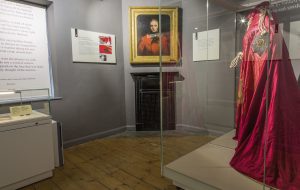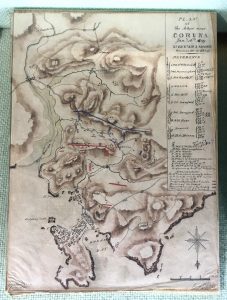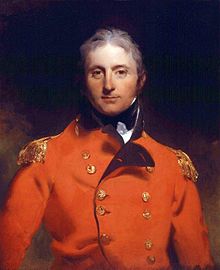January 16th , marks the anniversary of Sir John Moore’s death aged 47 in 1809, he was also known as Moore of Corunna, as he died at The Battle of Corunna, in Spain.
Sir John Moore is a hugely important figure in the development of The British Army because of his military training reforms and his special contribution to the Light Infantry in particular. Sir John Moore founded the Light Infantry; a new, elite kind of soldier whose uniform, equipment and tactics were revolutionised to allow them to move with stealth and speed.
We have a special display room at the museum, dedicated to Sir John Moore. Where we tell his story in more detail. We also have his rather impressive ceremonial Order of the Bath silk mantle on display as well as the sword he was wearing when fatally wounded at the battle of Corunna.

Sir Arthur Bryant wrote, “Moore’s contribution to the British Army was not only that matchless Light Infantry who have ever since enshrined his training, but also the belief that the perfect soldier can only be made by evoking all that is finest in man – physical, mental and spiritual“.
The Battle of Corunna
The Battle of Corunna took place in 1809, during the Napoleonic Wars. The British had been forced to withdraw to the Northern coast of Spain and planned to board ships at the Port of Corunna to escape the pursuing French army. Unfortunately, their transport ships were delayed, and the French were able to catch up and attack the British whilst they were still in the process of embarking the ships.
Whilst they were able to hold off the French and complete their escape; saving the army from complete destruction – the commander, Lieutenant-General Sir John Moore, was wounded. He died after several hours from severe injuries caused by cannon shot after learning his troops had successfully repelled the French attack and got away safely by sea.
We have a sketch map of The Battle of Corunna in our collection, it was made in July 1840 by Ensign Peter Hall of the 14th Regiment of Foot. At the time, an Ensign was the lowest rank of commissioned officer, and the ability to produce accurate field sketches, invaluable in battle – was one of the skills a young officer would be required to learn.
It’s thought that the map was most likely created as a practise exercise, possibly set by the Adjutant to all the junior officers. The fact that the map was made decades after the Battle of Corunna suggests that Corunna, as the final resting place of Sir John Moore, was a site of lasting importance to the Light Divisions – as in fact it still is today.


